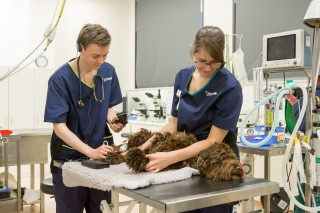
What is whelping?
Whelping is the process of a dog giving birth to puppies. Most dogs are capable of whelping on their own without difficulties. But you should keep a close eye on your dog throughout her late pregnancy and labour. Having a good idea of what’s normal for a dog in labour will allow you to spot signs of trouble early.
Dog labour complications
Dystocia is the term used to describe a difficult or abnormal birth and can occur at any stage of the birthing process. Dystocia requires emergency veterinary treatment.
You should contact your vet or, out of hours, your nearest Vets Now, if your dog’s labour lasts more than 24 hours, or if more than two hours pass in between puppies. This could be a sign of a serious difficulty, and both your dog and her unborn puppies could be at risk.
What causes dog dystocia?
There are many potential causes of dystocia in dogs. These can include issues with the fetus such as its size or position in the birth canal, and maternal problems such as poor contractions, an infection in the uterus or abnormalities in the pelvic canal, vaginal vault or vulvar opening. There are also factors that predispose dogs to dystocia such as age, obesity and sudden changes in their environment prior to going into labour.
Are some breeds more susceptible to dystocia?
Brachycephalic, also known as flat-faced or short-nosed breeds, particularly French bulldogs, Boston terriers, Chihuahuas and pugs are most likely to suffer complications giving birth, according to research from Vets Now. Our vets analysed data from the case notes of more than 18,000 dogs who had received emergency care at 50 Vets Now out-of-hours clinics and pet emergency hospitals across the UK.
Of those, 701 (3.7%) presented with dystocia. The research found some brachycephalic, or flat-faced, breeds were up to 16 times more likely than crossbreeds to suffer from dystocia. The most commonly affected breeds were French bulldogs (15.9 times more likely), Boston terriers (12.9 times more likely), Chihuahuas (10.4 times more likely) and pugs (11.3 times more likely).
How to tell if a puppy is in the breech position?
Puppies are usually born head first with the forelegs extended. They can also be born with the tail and hind legs coming first. An abnormal or breech presentation is one in which the hind legs are forward and the tail and bottom are presented. In these cases, the puppy will most likely have entered the birth canal tail first. You can usually tell if your dog’s puppy is in breech if their tail is seen hanging from the vulva, or there is a lump just behind the vulval lips and your dog is straining. Some breech presentations can be delivered without assistance, but often complications occur which require veterinary assistance.
You might also be interested in:
Taking your dog to the vet during labour
If you have any concerns during your dog’s pregnancy, particularly in the later stages, call your vet for advice. If you need to take her to the vet, take any puppies she has already delivered with you in a separate secure box with a hot water bottle or heat pad to keep them warm. Ensure the hot water bottle is well wrapped in a towel or similar to prevent overheating or burning the puppies. If it’s out of hours, contact your nearest emergency vet immediately.

Other related articles
How long are dogs pregnant for?
Most female dogs who have not been spayed go into heat every six months or so, although this can vary from breed to breed. The heat cycle tends to last between 18 and 21 days. Once your dog is pregnant, the gestation period begins. The normal length of the dog gestation period is typically between 62 and 64 days. If your dog is showing no signs of whelping 64 days after her last mating, contact your vet.
What are the stages of dog labour?
There are three stages of labour in dogs:
- the start of contractions
- delivery of puppies
- delivery of the placenta
How long are dogs in labour?
Labour can last for many hours but it often varies between breeds.
Dogs with slim heads such as collies and Dobermans, for example, may deliver all of their puppies within two to three hours. But brachycephalic (flat-faced) breeds, such as bulldogs and pugs, tend to have more difficult deliveries and will sometimes produce one or two puppies relatively quickly and then rest for a while before labour starts again.
Signs of a dog going into labour
Some dogs may be restless prior to going into labour. Others will stop showing an interest in food, although this isn’t always the case. These behaviours are often followed by repeated licking of the genitals. As birthing time approaches, your dog will begin to endure stronger and more frequent abdominal cramps and contractions. Your dog’s waters should then break. If her contractions continue for two hours without any signs of a watery discharge or puppies, call your vet.
Preparing for whelping
There are various things you can do to prepare for your dog going into labour. Most importantly, make sure you have your local daytime and out-of-hours vets’ numbers stored just in case there are complications. It’s also imperative you have a suitable whelping box, a supply of newspaper to line it with during delivery, and clean towels and paper towels on-hand to help with the clean-up. Other supplies you might need are sterilised scissors to cut the umbilical cord, unwaxed dental floss to tie off the cord, iodine to clean the puppies’ abdomens after the cord is cut, and heating pads or hot water bottles wrapped in towels to keep the puppies warm.
Delivering puppies at home
Make sure you keep her, and her newborns, under close surveillance in case they get into trouble. If you can see a puppy at the vulva and it is not being delivered, take a clean towel and gently take hold of the puppy. Gently pull the puppy at approximately 45° angle to the ground. Keep a constant pull even when your dog is not straining, as gentle traction will stimulate her to keep straining. If the puppy does not move or if it appears to be painful to your dog, contact your vet urgently.

